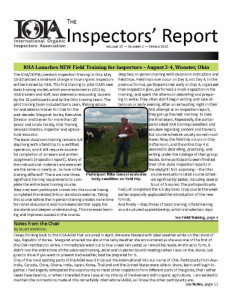 The Spring 2016 issue of The Inspectors’ Report has an article of local interest on page 16. It tells of the high level of training that is needed to obtain an working organic inspector status with USDA accredited certification agents. With first-hand knowledge of the narrative, the article is reprinted here for our blog readers.
The Spring 2016 issue of The Inspectors’ Report has an article of local interest on page 16. It tells of the high level of training that is needed to obtain an working organic inspector status with USDA accredited certification agents. With first-hand knowledge of the narrative, the article is reprinted here for our blog readers.
The IOIA Inspector’s Report Volume 25 – Number 2 – Spring 2016
Pursuing the Right Course by Alvie Fourness
Last month, I attended the International Organic Inspectors Association (IOIA) Organic Crop Inspection training held at Deer Creek Lodge and Conference Center in Mt. Sterling, Ohio. IOIA gave a training session by trainers Margaret Scoles and Jonda Crosby that was true to the IOIA mission to promote consistency and integrity in the organic certification process. There were 25 participants who attended from several states around the country including California, Oregon, Colorado, Wisconsin, and Kentucky to name a few, and one participant was from Canada. And, there was me coming from north-central Pennsylvania.
It was a demanding five day event with an abundance of class work, homework assignments and exercises. The highlight of the training came on Thursday with a mock inspection (a real-world scenario) of a 500 acre farm in organic production of wheat, corn and soybeans. Our class group was led by organic inspector, Doug Raubenolt at the Ohio Ecological Food and Farm Association (OEFFA). It was a spot on learning experience, as Doug provided us with much valuable guidance and mentoring. The farm inspection consisted of over three hours of information gathering and questioning the farmer about his practices and the farm’s organic system plan. After the farm inspection, it was back to the Deer Creek Lodge to debrief the inspection so as to get started writing the individually-written inspection reports that were due by 8 am the next morning. Much thought when into it; looking back through my notes where I jotted down my observations at the farm. And, much time was considered necessary for me to sort through the pages of written data gathered for the report. And then, there were the CFR Part 205 requirements to address and relate to the farm maps, fields, buffers and farm practices contained in the farmer’s organic system plan. My endeavor was to report the necessary information making the report complete, fair and accurate. I mostly finished the report by 2 am that night. Making it a point to awaking early enough in the morning to make some last-minute corrects and changes, somehow I met the submittal time. And the kicker was that the final exam started at 9 am on Friday morning. It took me the full three hours to finish the exam. In a seemly short flash of time, the course came to conclusion. And then, I was on my way driving back home to Pennsylvania after finishing one very tough course.
The course was not an easy one. The next steps to complete the training will be a few shadow inspections with an organic inspector mentor, where I go with an inspector on an inspection; and watch and learn. Then, finally an inspection or two where I actually conduct the inspection while being observed by the inspector mentor. That will then, if all goes well, complete the necessary training to become an organic inspector. Of course, then there are additional courses available for the taking that cover other organic categories such as process handling and livestock operations. Maybe these IOIA courses will become future purses of mine if I find this sort of work gainful. Let’s leave it as it’s too early to know for sure.
One might wonder; why one would want to be an organic inspector. It’s a fair question because it’s not an easy job. One important reason is that there is a need. The Organic Matters magazine published by the Pennsylvania Certified Organic (PCO) gave the follow data in the Fall 2015 edition, for a regional perspective to this need:
“Pennsylvania remains a powerhouse of organic production, maintaining its number three ranking with $3.13 million in organic “farmgate” sales, an increase of 47 percent. New York comes in at number seven with $1.64 million. In number of organic farms, New York ranks 3rd, with 917, and Pennsylvania are 5th, with 679. Additionally, the survey shows the potential for more growth with approximately 5,300 organic producers (39 percent) reporting that they intend to increase their organic production in the United States over the next five years. Another 688 farms with no current organic production are in the process of transitioning into organic agriculture production.”
An observation noted during the farm inspection for the IAOA course captures the above trends in increased organic production: Six (6) additional farms in the area were in transition to organic practices lessening the number for field buffers needed on the organic fields; thereby lessening the risk of contamination across neighboring farm boundaries. So it turned out that on my first farm inspection assignment, I got to verify a national trend that I was very pleased to see.
And also interestingly, while I was at the conference on Tuesday of that week, our farm’s updated organic certificate and Organic Product Verification (OPV) were sent to us arriving by email. The paperwork had the updated PCO logo. So, we also received a new copy of our farm’s organic certificate along with this year’s update. This timely correspondence gave me the added assurance coming when it did, that I was on the right path, and pursuing the right objectives at the right time.

Pingback: Thirteen Inspections Logged | Ravens Table Press
Pingback: Three States, Three Completions | Wooleylot's Blog